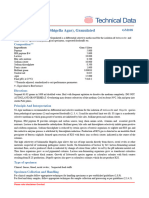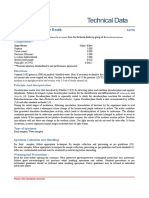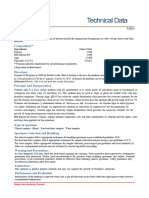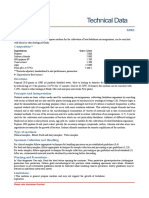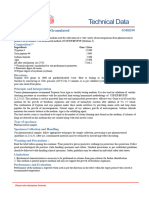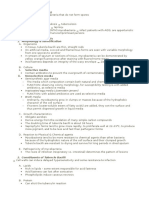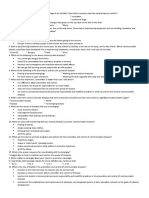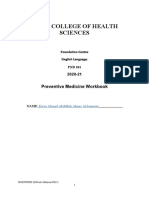TDS M317
Uploaded by
darrendelfinoy9TDS M317
Uploaded by
darrendelfinoy9R
Technical Data
EMB Agar M317
Intended Use:
For the isolation and differentiation of Gram-negative enteric bacteria from clinical and non-clinical specimens.
Composition**
Ingredients g/L
Peptone 10.000
Dipotassium hydrogen phosphate 2.000
Lactose 5.000
Saccharose (Sucrose) 5.000
Eosin - Y 0.400
Methylene blue 0.065
Agar 13.500
Final pH ( at 25°C) 7.2±0.2
**Formula adjusted, standardized to suit performance parameters
Directions
Suspend 35.96 grams in 1000 ml purified / distilled water. Mix until suspension is uniform. Heat to boiling to dissolve
the medium completely. Sterilize by autoclaving at 15 lbs pressure (121°C) for 15 minutes. AVOID OVERHEATING.
Cool to 45-50°C and shake the medium in order to oxidize the methylene blue (i.e. to restore its blue colour) and to suspend the
flocculent precipitate.(If EMB Agar is inoculated on the same day, it may be used without autoclave
sterilization). Precaution : Store the medium away from light to avoid photooxidation.
Principle And Interpretation
Eosin Methylene Blue (EMB) Agar was originally devised by Holt-Harris and Teague (1) and further modified by Levine
(2). The above medium is a combination of the Levine and Holt-Harris and Teague formulae which contains
peptone and phosphate as recommended by Levine and two carbohydrates as suggested by Holt-Harris
and Teague. Methylene blue and Eosin-Y inhibit gram-positive bacteria to a limited degree. These dyes serve as
differential indicators in response to the fermentation of carbohydrates. The ratio of eosin and methylene blue is
adjusted approximately to 6:1. Sucrose is added to the medium as an alternative carbohydrate source for typically
lactose-fermenting, gram-negative bacilli, which on occasion do not ferment lactose or do so slowly. The coliforms
produce purplish black colonies due to taking up of methylene blue-eosin dye complex, when the pH drops. The dye
complex is absorbed into the colony. Nonfermenters probably raise the pH of surrounding medium by oxidative
deamination of protein, which solubilizes the methylene blue-eosin complex resulting in colourless colonies (3). Some
strains of Salmonella and Shigella species do not grow in the presence of eosin and methylene blue. Further tests are
required to confirm the isolates.
Peptone serves as source of carbon, nitrogen, and other essential growth nutrients. Lactose and sucrose are the sources of
energy by being fermentable carbohydrates. Eosin-Y and methylene blue serve as differential indicators. Phosphate
buffers the medium.
The test sample can be directly streaked on the medium plates. Inoculated plates should be incubated, protected from light.
However standard procedures should be followed to obtain isolated colonies. A non-selective medium should be inoculated in
conjunction with EMB Agar. Confirmatory tests should be further carried out for identification of isolated colonies.
Type of specimen
Clinical samples- Faecal samples, Food samples, Water samples
Specimen Collection and Handling
For clinical samples follow appropriate techniques for handling specimens as per established guidelines (4,5).
For food samples, follow appropriate techniques for sample collection and processing as per guidelines (6).
For water samples, follow appropriate techniques for sample collection, processing as per guidelines and local standards (7).
After use, contaminated materials must be sterilized by autoclaving before discarding.
Please refer disclaimer Overleaf.
HiMedia Laboratories Technical Data
Warning and Precautions
In Vitro diagnostic use. For professional use only. Read the label before opening the container. Wear protective gloves/
protective clothing/eye protection/face protection. Follow good microbiological lab practices while handling specimens
and culture. Standard precautions as per established guidelines should be followed while handling clinical specimens.
Safety guidelines may be referred in individual safety data sheets.
Limitations :
1.Individual organisms differ in their growth requirement and may show variable growth patterns on the medium.
2.Each lot of the medium has been tested for the organisms specified on the COA. It is recommended to users to validate
the medium for any specific microorganism other than mentioned in the COA based on the user’s unique requirement.
3.Confirmatory tests should be further carried out for identification of isolated colonies.
Performance and Evaluation
Performance of the medium is expected when used as per the direction on the label within the expiry period
when stored at recommended temperature.
Quality Control
Appearance
Light pink to purple homogeneous free flowing powder
Gelling
Firm, comparable with 1.35% Agar gel.
Colour and Clarity of prepared medium
Reddish purple coloured, opalescent gel with greenish cast and finely dispersed precipitate forms in Petri plates
Reaction
Reaction of 3.6% w/v aqueous solution at 25°C. pH : 7.2±0.2
pH
7.00-7.40
Cultural Response
Cultural characteristics observed after an incubation at 35 - 37°C for 18 - 24 hours
Organism Inoculum Growth Recovery Colour of
(CFU) colony
# Klebsiella aerogenes 50-100 good 40-50% pink, without
ATCC 13048 (00175*) sheen
Escherichia coli 50-100 luxuriant >=50% purple with
ATCC 25922 black centre
(00013*) and green
metallic sheen
Klebsiella pneumoniae 50-100 good 40- 50% pink, mucoid
ATCC 13883 (00097*)
Proteus mirabilis ATCC 50-100 luxuriant >=50% colourless
25933
Salmonella Typhimurium 50-100 luxuriant >=50% colourless
ATCC 14028 (00031*)
Staphylococcus aureus >=104 inhibited 0%
subsp. aureus ATCC
25923 (00034*)
Key : (*) Corresponding WDCM numbers. (#) Formerly known as Enterobacter aerogenes
Storage and Shelf Life
Store between 10-30°C in a tightly closed container and the prepared medium at 20-30°C. Use before expiry date on the
label. On opening, product should be properly stored dry, after tightly capping the bottle in order to prevent lump formation
due to the hygroscopic nature of the product. Improper storage of the product may lead to lump formation. Store in dry
ventilated area protected from extremes of temperature and sources of ignition. Seal the container tightly after use. Product
performance is best if used within stated expiry period.
Please refer disclaimer Overleaf.
HiMedia Laboratories Technical Data
Disposal
User must ensure safe disposal by autoclaving and/or incineration of used or unusable preparations of this product. Follow
established laboratory procedures in disposing of infectious materials and material that comes into contact with clinical sample
must be decontaminated and disposed of in accordance with current laboratory techniques (4,5).
Reference
1.Holt-Harris and Teague,1916, J. Infect. Dis., 18 : 596.
2.Levine, 1918, J. Infect. Dis., 23:43.
3.Howard B.J., 1994, Clinical and Pathogenic Microbiology, 2nd ed., Mosby Year Book, Inc.
4.Salfinger Y., and Tortorello M.L. Fifth (Ed.), 2015, Compendium of Methods for the Microbiological Examination of
Foods, 5th Ed., American Public Health Association, Washington, D.C.
5.Lipps WC, Braun-Howland EB, Baxter TE,eds. Standard methods for the Examination of Water and Wastewater, 24th ed.
Washington DC:APHA Press; 2023.
6.Isenberg (Eds.), 1992, Clinical Microbiology Procedures Handbook, Vol . 1, American Society for Microbiology, Washington,
D.C.
7.Jorgensen, J.H., Pfaller, M.A., Carroll, K.C., Funke, G., Landry, M.L., Richter, S.S and Warnock., D.W. (2015) Manual of
Clinical Microbiology, 11th Edition. Vol. 1.
Revision : 04/2024
HiMedia Laboratories Pvt. Limited, IVD In vitro diagnostic 30°C Storage temperature
Plot No.C-40, Road No.21Y, medical device
MIDC, Wagle Industrial Area,
Thane (W) -400604, MS, India 10°C
EC REP CEpartner4U, Esdoornlaan 13, Do not use if
CE Marking
3951DB Maarn, NL package is damaged
www.cepartner4u.eu
Disclaimer :
User must ensure suitability of the product(s) in their application prior to use. Products conform solely to the information contained in this and
other related HiMedia™ publications. The information contained in this publication is based on our research and development work and is to the best
of our knowledge true and accurate. HiMedia™ Laboratories Pvt Ltd reserves the right to make changes to specifications and information related
to the products at any time. Products are not intended for human or animal or therapeutic use but for laboratory,diagnostic, research or further
manufacturing use only, unless otherwise specified. Statements contained herein should not be considered as a warranty of any kind, expressed or
implied, and no liability is accepted for infringement of any patents.
HiMedia Laboratories Pvt. Ltd. Corporate Office : Plot No.C-40, Road No.21Y, MIDC, Wagle Industrial Area, Thane (W) - 400604, India.
Customer care No.: 022-6147 1919 Email: techhelp@himedialabs.com Website: www.himedialabs.com




